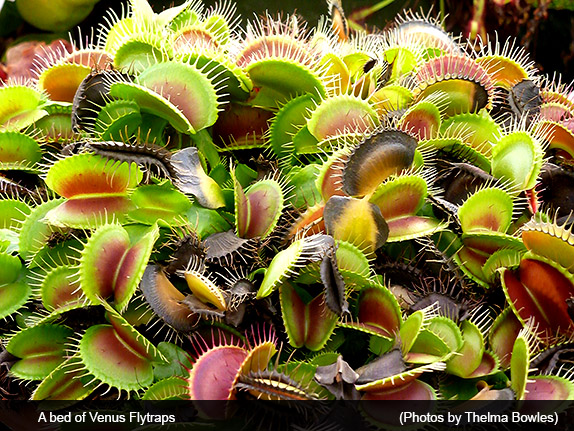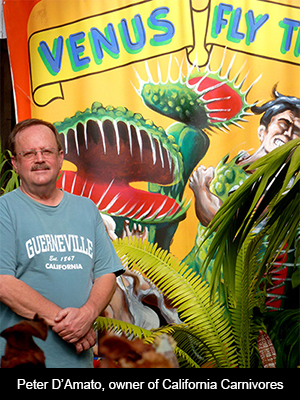Editor's note: Longtime New Mexico writer Wally Gordon who usually writes from Edgewood, New Mexico is dispatching from his rural romps in lesser traveled California

Peter D’Amato walks among the hundreds of plants arranged in rows in the country’s—and possibly the world’s —largest collection of flesh-eating plants until he reaches a Venus flycatcher with hungrily gaping petals. He carefully lifts a live worm and lays it on the lower petal.
Instantly the lower and upper petals curve creating a concave space. The petals clamp tightly together. The serrated edges of the petals lock together like bars of a prison. The flycatcher then begins an eight-to-ten-day process of ingesting the worm.
This is the eerie, beautiful and fascinating world of carnivorous plants. Once rarities, carnivorous plants have multiplied geometrically in recent years. “More species have been discovered in the last 20 years than in the previous 200 years,” D’Amato says.
If anybody knows what he is talking about in this odd corner of the plant kingdom it is D’Amato. In addition to owning California Carnivores, his plant collection and store in Sebastopol, Calif., he has written a standard book in the field, The Savage Garden: Cultivating Carnivorous Plants. Its first edition published in 1988 went through 12 printings and has won two major awards. The second edition has just been published by Berkeley Ten, an arm of the giant publishing firm Random House and is now available on Amazon.com. More than 300 articles have been written about him. He is also nearly 400 pages into a botanical horror novel he is writing called “A Crevice in Hell.”
 The idea of such plants as threats to mammals is not spurious. Large pitcher plants consume animals as large as rodents. One couple who came into D’Amato’s store said they saw a large pitcher plant in Malaysia eat a baby monkey. D’Amato is skeptical. “It was probably a large rat,” he says.
The idea of such plants as threats to mammals is not spurious. Large pitcher plants consume animals as large as rodents. One couple who came into D’Amato’s store said they saw a large pitcher plant in Malaysia eat a baby monkey. D’Amato is skeptical. “It was probably a large rat,” he says.
D’Amato has been involved with carnivorous plants since his childhood in the 1960s when “carnivorous plants first took hold of my life.”
In his book he says that when he was a teenager “you could count on one hand the serious growers of carnivorous plants in the United States. Since then, thousands of people all over the world have found the hobby an intoxicating experience. Carnivorous plants are educational, sometimes challenging, utterly and strangely beautiful, and a lot of fun to grow. Plus, unlike other plants, they don’t just sit there.”
While many new species have been discovered and expeditions are now commonly mounted to find still more, the plants are seriously threatened by disappearance of their habitat. They only grow in certain conditions. They need lots of water and a shallow water table with poor soil. In fact, it is their inability to get nourishment from the soil that caused the plants to develop the ability to trap and consume flies, ants, worms, tadpoles, spiders, frogs, lizards and rats.
These animals, D’Amato says, are “like vitamin pills with legs and wings.”
The area in the world that is most conducive to carnivorous plants is the southeastern United States, especially the coastal areas of North Carolina. But destruction of wetlands has virtually eliminated their habitat except in protected public or private sites. He bewails the “heartbreaking fact: these astounding forms of life are disappearing from our planet at a rate that is beyond alarming.”
He describes hunting for Venus flytraps “along dismal drainage ditches along the sides of roads, where occasional patches of Venus flytraps, sundews and pitcher plants barely survived among broken bottles and discarded fast-food containers.”
In his play Suddenly Last Summer, Tennessee Williams writes of “the Venus Flytrap, a devouring organism, aptly named for the goddess of love.” (By coincidence, the play was playing at a community theater in a town near Sebatopol the week I talked to D’Amato. He was going to see it that weekend.)
Love and biology also combined for D’Amato. As a kid he saw an ad about Venus flytraps eating hamburger and ordered some, but they died. “It was my first experience with unrequited love,” he adds. “It was the beginning of a mind-boggling adventure that would change my life.”
Such plants have fascinated millions of people. “Humans love to project their own fears onto other life forms,” D’Amato says. Four horror movies—The Thing, Day of the Tiffids, Invasion of the Body Snatchers and Little Shop of Horrors—feature flesh-eating plants. “Our ancestors had good reason to fear plants,” D’Amato says.
A false story widely circulated in Europe in 1878 of the discovery of the Man-Eating Tree of Madiscar to which a young maiden was sacrificed.
Even a scientist as renowned as Charles Darwin was fascinated by these plants and spent 20 years studying them.

Scientific peculiarities aside, the pants are stunningly gorgeous. Their rich green leaves are often vividly shiny and their flowers huge and multicolored. They are as spectacular as any plants on Earth.
There are other species of plants akin to carnivores but distinctly different because they don’t actually consume the animals they trap. What happens is that these plants are hosts to “assassin bugs.” After the plant’s leaves trap an animal with their sticky substance, bugs that live on the plant consume the trapped animals and then they themselves exude nutrients that in turn feed the plants.
D’Amato has taken on a young partner, Damon Collingsworth, who bought his first plant in D’Amato’s store at the age of 12 and has been involved with carnivores ever since. He traveled to Borneo to work for a tropical pitcher plant lab.
As devoted as D’Amato is to carnivores, he is also ambivalent about them. While feeding a live animal to a Venus flycatcher, he remarks, “I hate doing this. In my old age I rescue frogs. But as a kid it was fun.” He adds, “Nature is so cruel.”



Responses to “Plants that don’t just sit there”